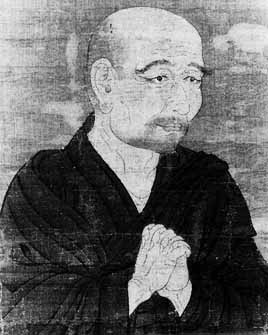The Buddhist Route for Transmission of Days of the Week: Esoteric Buddhism and Astrology
 |
Click on the picture for more about Bu Kong and other great Buddhist
monks in the line of tradition brought to Japan by Kobo Daishi (Japanese-enabled
browsers only). |
According to the author Kiyoshi Yabuuchi, quoted at Professor Yasuaki Nakano's site (Japanese only), the days of the week were noted in 大孔雀呪王経 ('Grand Peacock Exorcises the King Sutra') as translated by the Chinese Buddhist monk Yi Jing (義淨 / 义净 Yì Jìng, 635-713) - although this work refers to nine luminaries, not seven.
The planetary names were also introduced by Bu Kong (不空 Bù Kōng, 705-774, picture at left), a major figure in esoteric Buddhism who enjoyed the patronage of the Tang Imperial court. Bu Kong's birthplace is unknown, being variously given as Sri Lanka and Central Asia.Bu Kong set down prevailing Indian astrological theories in his Xiuyaojing (宿曜經 Xiùyào Jīng ), written with the help of a Chinese disciple, Shi Yao (石瑶 Shí Yào) during the 8th century. The Xiuyaojing analysed the influence of the stars on lucky and unlucky days and human fate.
While it may sound outdated and superstitious, the Xiuyaojing should not be dismissed as a quaint astrological work. Astrology was a serious business used for predicting astronomical and political affairs in the ancient world. In China, for instance, the Buddhists used their advanced astrological techniques to strengthen their position against the established native tradition of Yin (陰 yīn, simplified 阴), Yang (陽 yáng, simplified 阳), and the Five Elements (五行 wǔ xíng).
Although it's beyond the scope of this site, we'll take a brief look below at the sources of Buddhist astrology. Despite marked differences in flavour between the astrological week of esoteric Buddhism and the Christian week that the West inherited from the Roman Empire, the seven days both ultimately derive from the same source.
The sources of Buddhist astrology are:
1) The zodiac. The zodiac appears to have originated in ancient Egypt on the basis of Babylonian astrology and was then adopted and systematised by the Greeks. It spread to India as a part of the dissemination of Hellenistic knowledge that took place in the centuries following Alexander the Great's conquest of the east after 334 B.C. For a time, the Indians used Greek names for the constellations of the zodiac.
2) The seven luminaries. According to Kiyoshi Yabuuchi, the 'seven luminaries' came to India from the West in about the 5th century, although their use was confined to astronomers until the 9th century. Sanskrit used day names based on the seven planets. (Indian astrology also used nine luminaries.)
3) The '28 Constellations' (二十八宿 èrshíbā-xiù). The 28 constellations may have originated in China in the Zhou dynasty (1100-221 BC) and subsequently found their way to India, where they were reduced to 27 and imbued with superstitious content. Another theory is that the Chinese and Indian constellations developed independently of each other, with the Indian being older.
In China, the 28-day Chinese version gradually displaced the Indian one for astrological purposes. The Chinese divided the heavens into 28 constellations located along the Equator and the ecliptic, each named after a star in the vicinity. In the course of a month, the moon would progress through one constellation each day. The 28 constellations were divided into four groups: the seven stars of the east, the seven stars of the north, the seven stars of the west, and the seven stars of the south. This effectively divided the month into four lots of seven days.
After Bu Kong's Xiuyaojing was introduced to Japan, the 宿曜 xiùyào (sukuyō or shukuyō in Japanese) became popular among the nobility as a kind of equivalent to the modern horoscope. Even now, there are Japanese sites on the Internet pushing the virtues of the 宿曜 sukuyō as a means of analysing individual fate and personality based on birth dates. (For an example, see this site. Japanese only.)
For detailed, if sometimes conflicting information on the development of the zodiac, see Robert Hand's 'History of Astrology - Another View', the Encyclopedia Britannica article on Astrology, the Astrology Timeline, the Awakening Love site, and the History of Astrology site, which presents an Indian view. The site Onmyodo & Sukuyodo (Japanese only) covers the origins of the 'onmyodo' and the 'sukuyodo', Chinese and Indian astrological traditions adopted by the Japanese, in some detail. Several Taiwanese Buddhist web sites deal with Buddhist astrology, including the seven luminaries, e.g. Secret of the Buddhist Signs of the Zodiac and Principles for Erasing Disaster and Bringing Good Luck, both Chinese-language sites using Big5 encoding.
The 28 constellations are discussed at Star Charts and Moon Stations in Steve Renshaw's Astronomy in Japan site. Graphic representations of the four groups of seven constellations or 'moon stations' are given at Azure Dragon of the East, the Black Tortoise of the North, the White Tiger of the West, and the Red Bird of the South, along with the Chinese character for each constellation. More information on the difference between Indian and Chinese constellations can be found at the Asian Stellar Myths and Legends site and the 28 constellations site (both Japanese only).